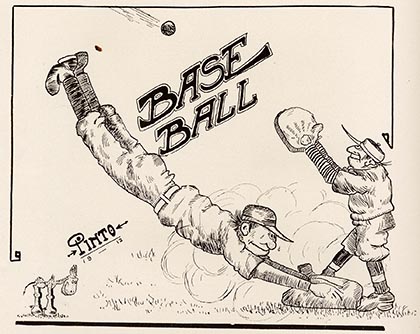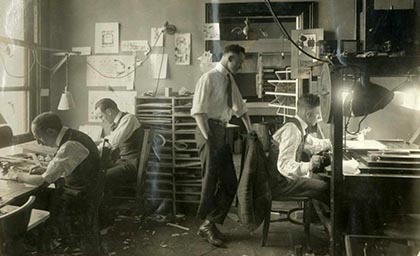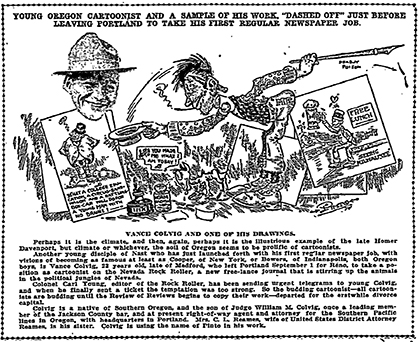JACKSONVILLE, JACKSON COUNTY; 1900s, 1910s:
Goofy, Bluto, Bozo were all Oregon’s ‘Pinto’ Colvig
Audio version: Download MP3 or use controls below:
|
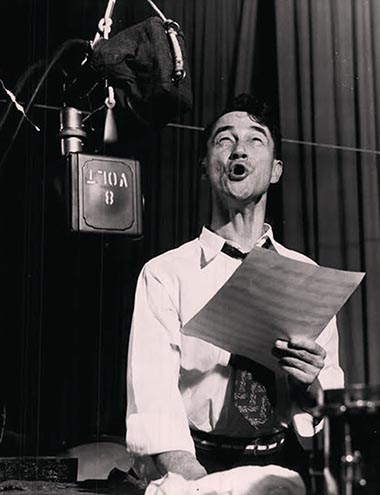
But in 1916 he got married, and soon was in San Francisco with a family to support. While working at the Chronicle there, he started dabbling in a brand-new field of show business, one uniquely suited to a fast-sketching “chalk-talker” like Pinto: Animation. In those days, animation was not done with clear celluloid or acetate “cels” — it was done with paper cut-outs simply laid down on the background. Each had to be sketched and cut out, 12 of them per second of film. Pinto spent years in the broiling heat of the massive floodlights, sketching and cutting and positioning and shooting animations frame by frame, in his own studio — Pinto Cartoon Comedies Company — and others. He produced what he claimed was the world’s first feature-length animated cartoon, a work called “Creation” — and, in fact, it probably was, but so little of that early animation and movie work survives that we can’t be sure. In fact, all that’s left of “Creation” is a frame from the title card. By the mid-1920s, Pinto was in Hollywood and making a name there. At the time, comedy movies were being made using very dangerous stunts, and a skilled animator could actually save lives by providing the 1920s equivalent of green-screen work. Some of his animated interventions can be seen on old Buster Brown comedies, among others. 
Pinto voiced the part of Goofy as a cool cigarette-smoking Argentine gaucho in the 1942 cartoon "El Gaucho Goofy," part of a four-part set titled "Saludos Amigos," a sort of Disney goodwill tour of South America commissioned by the U.S. State Department during World War II . (Animated GIF created by mothgirlwings.tumblr.com from Disney cartoon)In 1930, Pinto joined forces with Walt Disney, and his most enduring character — Goofy — got his start. Over the following dozen years or so, Pinto worked with Disney and other Hollywood producers on some of his most memorable projects. He was the voice of Grumpy and Sleepy in “Snow White”; some of the Munchkins on “The Wizard of Oz”; Gabby in “Gulliver’s Travels”; Bluto in the “Popeye the Sailor” cartoons; and even (with the help of his battered old trombone) Jack Benny’s legendary Maxwell motorcar. After the war, Pinto landed his other major role. He was cast as the voice of Bozo the Clown in the original Capitol Records series, and actually played the clown personally in a television series starting in 1949. Pinto died in 1967 at the age of 75. He’d been a heavy smoker all his life, like so many others in his creative set, and the cause of death — as with his colleague and former boss, Walt Disney, three years before — was lung cancer. In his later years, Pinto campaigned to force tobacco companies to put warning labels on cigarettes, but he himself was never able to break the addiction, and eventually it took him down. Pinto was one of the earliest pioneers of animated cartoons. Although virtually nothing remains of his work from before he signed with Disney, techniques that he developed are still in use today. And although his name isn’t as well known with the general public as Disney’s, among professional animators, cartoonists, clowns and Foley sound technicians, he’s a legend.
|
Background photo is a hand-tinted postcard image showing the Portland harbor and waterfront on a busy day, on a picture postcard published around 1925.
Scroll sideways to move the article aside for a better view.
Looking for more?
On our Sortable Master Directory you can search by keywords, locations, or historical timeframes. Hover your mouse over the headlines to read the first few paragraphs (or a summary of the story) in a pop-up box.
... or ...
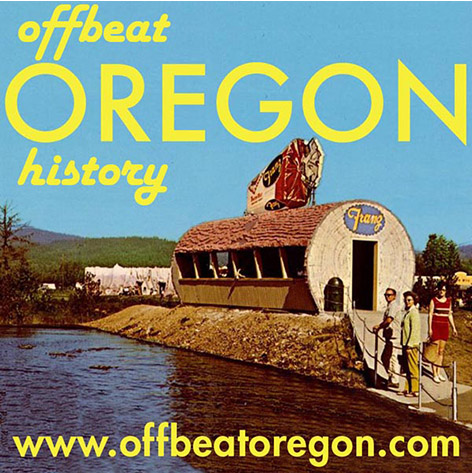
©2008-2014 by Finn J.D. John. Copyright assertion does not apply to assets that are in the public domain or are used by permission.

